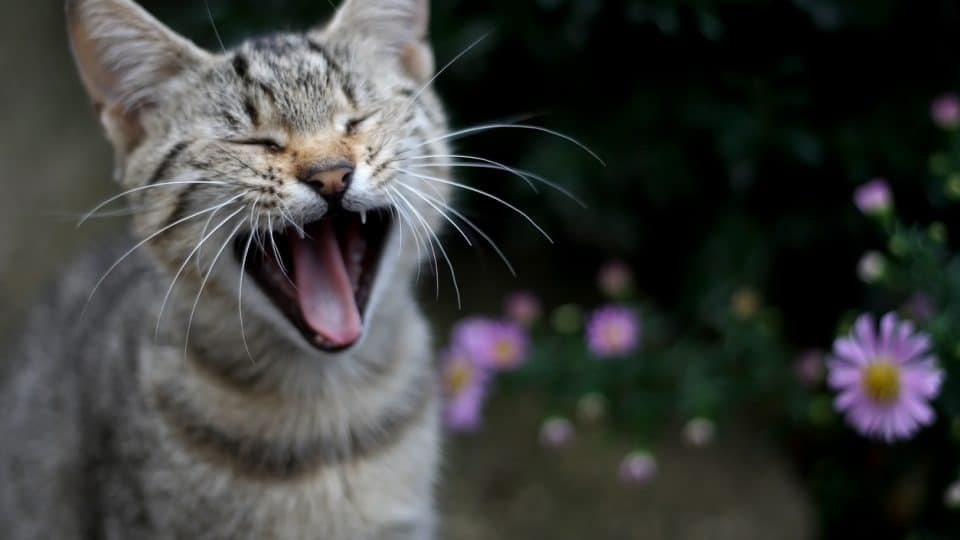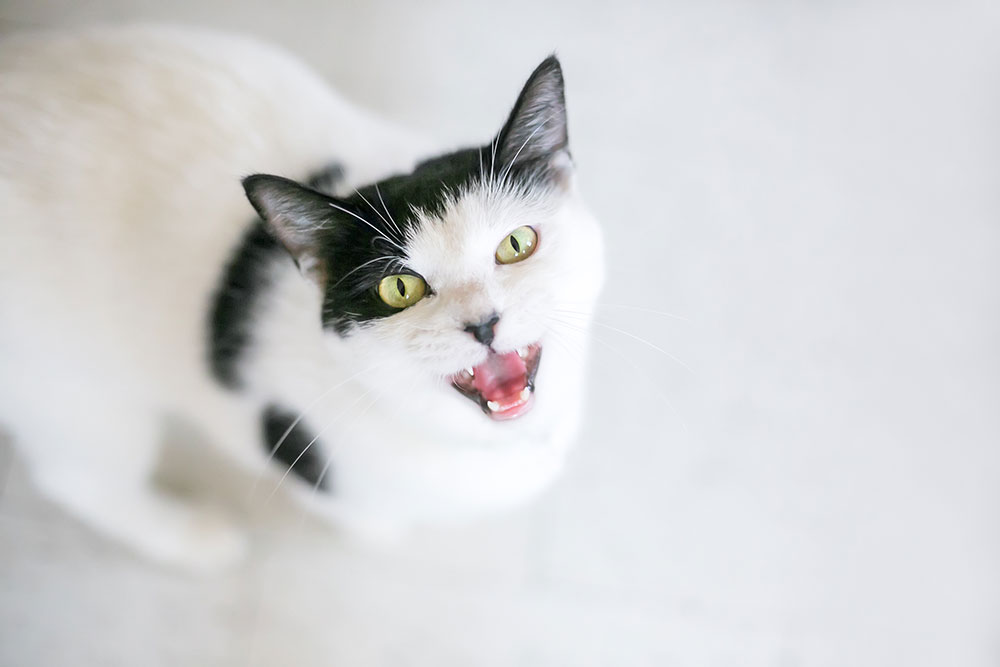A spayed female cat may yowl for various reasons. It could be due to hormonal changes post-spaying, seeking attention, or underlying medical discomfort. Cats use yowling as a form of communication, expressing their needs or reacting to stress. Environmental changes, loneliness, or even boredom can trigger this behavior.
To address yowling, create a comfortable environment, engage in interactive play, and offer mental stimulation. Positive reinforcement for desired behaviors can also help. If nocturnal yowling becomes an issue, establish a consistent bedtime routine. Always consult with a veterinarian to rule out any health concerns and ensure your cat’s well-being
How to Understand Cat Communication Through Their Vocalization?

Cat communication through vocalization involves paying attention to the various sounds they make, such as purring, meowing, hissing, and yowling, each of which conveys different emotions and needs.
By observing the context and nuances of these vocalizations, cat owners can develop a deeper connection with their feline companions and respond appropriately to their behaviors.
| Vocalization | Sound Description | Meaning | Context/Insight |
| Purring | Low-frequency rumbling | Contentment, relaxation, self-soothing (pain relief) | It may indicate happiness or serve as a self-healing mechanism. |
| Meowing | Varied pitch and tone | Communication with humans; signifies needs | Pay attention to pitch, volume, and frequency for nuanced communication. |
| Hissing | Sharp, high-pitched noise | Fear, aggression, discomfort | Defensive posture accompanies, giving space to avoid escalation. |
| Growling | Low, guttural noise | Sign of aggression or discomfort | Indicates discomfort or perceived threat; handle with caution. |
| Chirping | Bird-like noises | Playful or frustrated during prey observation | Mimics sounds of prey; provide outlets for hunting instincts. |
| Trilling | Soft, melodic noises | Friendly greeting or expression of happiness | Indicates a positive and social communication method. |
| Yowling | Loud, drawn-out cries | Distress, mating behavior, or attention-seeking | Context matters; may signify a need for intervention or addressing behavior. |
However, yowling is a special language for cats, and cat owners must pay attention to it. When your cat yowls, it’s often trying to tell you something important. Sometimes, especially for unspayed females or unneutered males, it can be a way of saying, “I’m looking for a mate!” If your cat isn’t in the mood for love, persistent yowling might indicate discomfort or a need for attention.
What Are The Common Reasons for Yowling in Spayed Female Cats?
Hormonal Changes Post-Spaying
Yowling in spayed female cats can be linked to hormonal changes experienced after the spaying procedure.
Even though spaying involves the removal of the ovaries and uterus, some hormonal fluctuations can occur, affecting a cat’s behavior. The abrupt alteration in hormone levels may lead to a temporary imbalance, resulting in yowling as the cat adjusts to the new hormonal environment.
Yowling is a possible consequence of hormonal shifts post-spaying helps owners recognize it as a natural part of the adjustment period. In most cases, this behavior tends to diminish as the cat fully adapts to the altered hormonal state.
Attention-Seeking Behavior
Yowling can also be a form of attention-seeking behavior in spayed female cats.
Some cats, regardless of their spaying status, may use vocalizations as a means to grab their owner’s attention. This can be especially true if the cat has learned that yowling results in a response, whether it’s extra playtime, treats, or simple companionship.
To address attention-seeking yowling, cat owners need to provide regular interactive play, mental stimulation, and affection. Establishing a consistent routine and rewarding positive behavior can help reduce excessive attention-seeking vocalizations.
Medical Issues that May Cause Discomfort
Yowling in spayed female cats can sometimes indicate underlying medical issues causing discomfort.
While spaying typically prevents certain health issues, cats can still experience conditions such as urinary tract infections, arthritis, or dental problems. Yowling may serve as a way for the cat to communicate pain or distress related to these health issues.
Regular veterinary check-ups are necessary to rule out any potential medical causes for yowling. If a cat is yowling persistently, especially if it’s a change in behavior, it’s important to consult with a veterinarian to identify and address any health concerns promptly.
How Do Behavioral Changes Influence Feline Actions?

The Role of Stress and Anxiety in Cat Behavior
Stress and anxiety can significantly impact a spayed female cat’s behavior, potentially leading to yowling.
Cats are sensitive creatures, and changes in their environment, routine, or social dynamics can induce stress.
Common stressors include the introduction of new pets, changes in the household, or even disruptions to their usual feeding or playtime schedules. Yowling may manifest as a vocal expression of their discomfort or unease.
Recognizing signs of stress, such as hiding, excessive grooming, or changes in appetite, alongside yowling, can help cat owners identify and address the underlying sources of anxiety. Creating a calm and predictable environment, providing hiding spots, and offering positive reinforcement during stressful situations can help alleviate anxiety-related behaviors.
Territorial Instincts in Spayed Female Cats:
Territorial instincts play a crucial role in a cat’s behavior, and spayed female cats may still exhibit territorial behaviors leading to yowling.
Even after spaying, cats retain their territorial instincts. Yowling can serve as a vocal assertion of territory, especially in multi-cat households or when encountering unfamiliar scents or changes in their living space. It can be a way of marking their presence and establishing boundaries.
Providing separate feeding and resting areas for each cat, ensuring there are ample resources, and using pheromone diffusers can help mitigate territorial conflicts.
How Environmental Changes Can Trigger Yowling
Environmental changes, whether subtle or significant, can be a trigger for yowling in spayed female cats.
Cats are creatures of habit, and alterations to their surroundings, such as moving to a new home, rearranging furniture, or even changes in the household members, can induce stress and confusion. Yowling may be a response to these changes as the cat attempts to make sense of and assert control over its environment.
When introducing environmental changes, gradual transitions and maintaining familiar items, such as bedding or toys, can help ease the cat into the new environment.
Providing safe spaces, using pheromone diffusers, and offering extra attention during adjustment periods can reduce stress-related yowling.
FAQ
Do spayed female cats still call?
Yes, spayed female cats can still vocalize, including yowling. While spaying reduces mating-related calls, other factors like attention-seeking or environmental changes can contribute to continued vocalization.
How long do female cats take to heal from spay?
The healing time for a female cat after spaying is typically around 10 to 14 days. It’s essential to follow post-surgery care guidelines provided by your veterinarian to ensure a smooth recovery.
How long does a female cat take to recover from spaying?
The recovery period for a female cat after spaying is generally a few days to a couple of weeks. Monitoring her behavior and providing a comfortable environment aids in a speedy recovery.
What is the behavior of a female cat after being spayed?
Post-spaying, a female cat may exhibit temporary changes such as increased rest, reduced aggression, and sometimes heightened vocalizations. However, individual responses can vary.
Is spaying a female cat painful?
Yes, spaying involves surgery, so there is some discomfort. However, veterinarians use anesthesia and pain management to minimize pain, and the long-term benefits for the cat’s health outweigh the temporary discomfort.
Do female cats get moody after being spayed?
While some behavioral changes are expected post-spaying, moodiness is generally temporary. Hormonal adjustments may lead to mild shifts in behavior, but these usually stabilize over time.
Why does my spayed cat yowl at night?
Yowling in a spayed cat at night can be due to various factors, such as environmental changes, seeking attention, or expressing discomfort. Understanding the specific cause is crucial in addressing this behavior.
How do I know if my cat is in pain after surgery?
Signs of pain in a cat post-surgery include changes in behavior, decreased activity, excessive grooming of the surgical site, and vocalization. Regular monitoring and consulting with the vet ensure prompt pain management.
Are spayed female cats aggressive?
Spaying usually reduces aggression in female cats. However, individual temperament, past experiences, and the overall environment also play significant roles in a cat’s behavior. Regular socialization and positive reinforcement can help manage aggression.
Final words
Understanding why your spayed female cat is yowling is vital for a happy and harmonious relationship. Whether it’s hormonal adjustments, attention-seeking, or a response to stress, being aware of these factors helps you respond appropriately.
Remember, patience is key, especially during the initial months post-spaying.
If yowling persists or seems linked to discomfort, consulting a vet is wise. By creating a calm environment, addressing behavioral needs, and staying attuned to your cat’s cues, you can foster a strong bond and ensure a contented and quiet household. With care and understanding, you and your feline friend can navigate the yowling mystery together.

